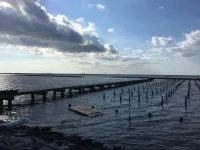(Press-News.org) LA JOLLA, CA--Fast-spreading variants of the COVID-19-causing coronavirus, SARS-CoV-2, carry mutations that enable the virus to escape some of the immune response created naturally or by vaccination. A new study from scientists at Scripps Research, along with collaborators in Germany and the Netherlands, has revealed key details of how these escape mutations work.
The scientists, whose study appears in Science, used structural biology techniques to map at high resolution how important classes of neutralizing antibodies bind to the original pandemic strain of SARS-CoV-2--and how the process is disrupted by mutations found in new variants first detected in Brazil, the United Kingdom, South Africa and India.
The research also highlights that several of these mutations are clustered in one site, known as the "receptor binding site," on the spike protein of the virus. Other sites on the receptor binding domain are unaffected.
"An implication of this study is that, in designing next-generation vaccines and antibody therapies, we should consider increasing the focus on other vulnerable sites on the virus that tend not to be affected by the mutations found in variants of concern," says co-lead author Meng Yuan, PhD.
Yuan is a postdoctoral research associate in the laboratory of senior author Ian Wilson, DPhil, Hansen Professor of Structural Biology and Chair of the Department of Integrative Structural and Computational Biology at Scripps Research.
How 'variants of concern' escape immune response
SARS-CoV-2 "variants of concern" include the UK's B.1.1.7 variants, South Africa's B.1.351 variants, Brazil's P.1 variants and India's B.1.617 variants. Some of these variants appear to be more infectious than the original Wuhan strain. Recent studies have found that antibody responses generated through natural infection to the original strain or via vaccination are less effective in neutralizing these variant strains.
Because of the variants' potential to spread and cause disease--perhaps in some cases, despite vaccination--scientists consider it urgent to discover how the variants manage to escape much of the prior immune response in the body, including the antibody response.
In the study, the researchers focused mainly on three mutations in the SARS-CoV-2 spike protein: K417N, E484K and N501Y. Alone or in combination, these mutations are found in most major SARS-CoV-2 variants. All of the mutations are found in the SARS-CoV-2 receptor binding site, which the where the virus attaches to host cells.
The researchers tested representative antibodies from the major classes that target the general area in and around the receptor binding site. They found that many of these antibodies lose their ability to effectively bind and neutralize the virus when the mutations are present.
Using structural imaging techniques, the team then mapped the relevant portion of the virus at atomic-scale resolution to examine how the mutations affect sites where antibodies otherwise would bind and neutralize the virus.
"This work provides a structural explanation for why antibodies elicited by COVID-19 vaccines or natural infection by the original pandemic strain are often ineffective against these variants of concern," Wilson says.
Zeroing in on points of vulnerability
The findings suggest that while antibody responses to the SARS-CoV-2 receptor binding site can be very potent in neutralizing the original Wuhan strain, certain variants are able to escape--perhaps eventually necessitating updated vaccines.
At the same time, the study underlines the fact that the three key viral mutations, which SARS-CoV-2 seems inherently prone to develop, do not alter other vulnerable sites on the virus outside the receptor binding site. The researchers specifically showed that virus-neutralizing antibodies targeting two other areas outside the receptor binding site were largely unaffected by these three mutations.
This suggests that future vaccines and antibody-based treatments could provide broader protection against SARS-CoV-2 and its variants by eliciting or utilizing antibodies against parts of the virus that lie outside the receptor binding site. The researchers note that broad protection against variants may be necessary if, as seems likely, the virus becomes endemic in the human population.
The Wilson lab and collaborators in this study are continuing to study human antibody responses to variants of concern and hopes to identify strategies for broad protection against not only SARS-CoV-2 and its variants but also SARS-CoV-1 and other related, emergent coronaviruses.
INFORMATION:
The study, "Structural and functional ramifications of antigenic drift in recent SARS-CoV-2 variants" was authored by Meng Yuan, Deli Huang, Chang-Chun Lee, Nicholas Wu (co-lead authors), and by Abigail Jackson, Xueyong Zhu, Hejun Liu, Linghang Peng, Marit van Gils, Rogier Sanders, Dennis Burton, S. Momsen Reincke, Harald Prüss, Jakob Kreye, David Nemazee, Andrew Ward and Ian Wilson.
Support for the research was provided by the Bill & Melinda Gates Foundation (OPP1170236, INV-004923), the National Institutes of Health (R00 AI139445, P01 AI110657, R01 AI132317, R01 AI142945), the German Research Foundation (PR 1274/3-1, PR 1274/5-1), the Helmholtz Association (HIL-A03 482, SO-097) and the German Federal Ministry of Education and Research (01GM1908D).
Environmental quality is associated with advanced-stage prostate cancer at diagnosis, according to a new study by University of Illinois Chicago researchers.
Prostate cancer is up to 57% heritable, with the remainder attributed to environmental exposures. However, studies on those environmental factors and prostate cancer aggressiveness have previously been limited. For their study, "Association between environmental quality and prostate cancer at diagnosis," published in the journal Prostate Cancer and Prostatic Disease, researchers paired data from the environmental quality index, or EQI, and the Surveillance, ...
Around the world and within the U.S., the percentage of people wearing masks during the Covid-19 pandemic has varied enormously. What explains this? A new study co-authored by an MIT faculty member finds that a public sense of "collectivism" clearly predicts mask usage, adding a cultural and psychological perspective to the issue.
The study uses a series of datasets about mask usage and public attitudes, along with well-established empirical indices of collectivism, to evaluate the impact of those cultural differences on this element of the pandemic response. ...
Flies predict changes in their visual environment in order to execute evasive maneuvers, according to new research from the University of Chicago. This reliance on predictive information to guide behavior suggests that prediction may be a general feature of animal nervous systems in supporting quick behavioral changes. The study was published on May 20 in PLOS Computational Biology.
Animals use their sensory nervous systems to take in information about their environments and then carry out certain behaviors in response to what they detect. However, the nervous system takes time ...
The immune system is a complex balancing act; if it overreacts or underreacts to foreign molecules, there can be serious health consequences.
For cancer patients, tumor progression is often accompanied by immunosuppression, meaning their bodies can't fight off pathogens the way they should. By contrast, for people with autoimmune diseases like type 1 diabetes, rheumatoid arthritis, and multiple sclerosis, their immune systems overreact and attack the body itself.
Both of these reactions are influenced by a series of molecular checkpoints found in both immune cells and cancer cells. In immune ...
Oysters live and grow in saltwater. However, the saltiness of their habitat can change dramatically, especially where the mighty Mississippi River flows into the Gulf of Mexico. Louisiana oysters from the northern Gulf of Mexico may experience some of the lowest salinity in the world due to the influx of fresh water from the Mississippi River. In addition, increased rainfall and large-scale river diversions for coastal protection will bring more fresh water that does not bode well for the eastern oyster. New research led by Louisiana State University (LSU) alumna Joanna Griffiths from Portland, Oregon, and her faculty advisor ...
ROCHESTER, Minn. -- You might be older - or younger - than you think. A new study found that differences between a person's age in years and his or her biological age, as predicted by an artificial intelligence (AI)-enabled EKG, can provide measurable insights into health and longevity.
The AI model accurately predicted the age of most subjects, with a mean age gap of 0.88 years between EKG age and actual age. However, a number of subjects had a gap that was much larger, either seemingly much older or much younger by EKG age.
The likelihood to die during follow-up was much ...
During the pandemic, the old waiting room phrase "the doctor will see you now" has taken on a new meaning. So has the waiting room. Our kitchen table or living room couch is where many people do work lately, and that includes visits to the doctor. New research from Syracuse University's Falk College indicates this method of health care will continue even after COVID numbers are (hopefully) reduced.
"I was surprised by the results," said the study's lead author Bhavneet Walia, assistant professor of public health at Syracuse University. "I initially thought that, because of the challenges of telehealth, physicians would not be in favor of continuing post-pandemic. It turns out they do. But ...
Researchers have long been interested in finding ways to use simple hydrocarbons, chemicals made of a small number of carbon and hydrogen atoms, to create value-added chemicals, ones used in fuels, plastics, and other complex materials. Methane, a major component of natural gas, is one such chemical that scientists would like to find to ways to use more effectively, since there is currently no environmentally friendly and large-scale way to utilize this potent greenhouse gas.
A new paper in Science provides an updated understanding of how to add functional groups onto simple hydrocarbons like methane. Conducted by graduate students Qiaomu Yang and Yusen Qiao, postdoc Yu Heng Wang, and led by professors Patrick J. Walsh and Eric J. Schelter, this new and highly detailed mechanism ...
HOUSTON - (May 20, 2021) - It's always good when your hard work reflects well on you.
With the discovery of the giant polarization rotation of light, that is literally so.
The ultrathin, highly aligned carbon nanotube films first made by Rice University physicist Junichiro Kono and his students a few years ago turned out to have a surprising phenomenon waiting within: an ability to make highly capable terahertz polarization rotation possible.
This rotation doesn't mean the films are spinning. It does mean that polarized light from a laser or other source can now be manipulated in ways that were previously out of reach, making it completely visible or completely opaque with a device that's extremely ...
At the start of the COVID-19 outbreak, a University of Illinois Chicago researcher conducted a survey asking respondents if they experienced health care delays because of the pandemic. In addition to learning about the types of delays, the study also presented a unique opportunity to capture a historic moment at the pandemic's beginning.
Elizabeth Papautsky, UIC assistant professor of biomedical and health information sciences, is first author on "Characterizing Healthcare Delays and Interruptions in the U.S. During the COVID-19 Pandemic Using Data from an Internet-Based Cross-Sectional ...




